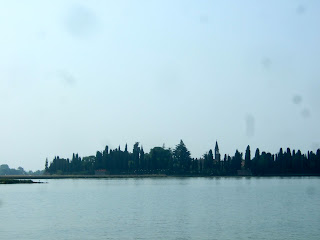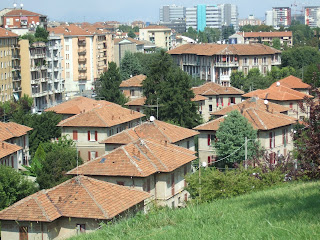A row of tall cypresses encircles the island of San Francesco del Deserto in Venice, a dark green wall that seems to emerge from the water of the northern lagoon to shelter the island from strong winds and erosive tides, but, above all, to protect its silence. Life here is pervaded by silence, a silence broken only by the sounds of nature and by the prayers of a small community of Franciscan monks, the only inhabitants of the island from the 13th century. Saint Francis stopped here on his return trip from the East in 1220, and, for a few weeks, peace and a multitude of swallows were his only companions. Over the years, the atmosphere of the island has not changed much, but, in the last months, the private boats that connect San Francesco del Deserto to the nearby island of Burano have been busier than usual transporting visitors and materials for the exhibition Oltre il Paesaggio mistico, 'Beyond the Mystical Landscape.' The event, conceived by the Association ARTLIFE for the World curated by Simonetta Gorreri, and promoted, among other institutions, by the MiBAC, the Italian Ministry for Cultural Heritage Activities, was part of the initiatives connected with the 55th International Art Exhibition, the Venice Art Biennale 2013. From June 1 to August 20, the exhibition 'Beyond the mystical landscape' involved 11 artists who explored and interpreted the past and present life of this special island. Their installations of land and water art were arranged along a path that unfolded from the inner part of the monastery, through the park, to the lagoon, from inside to outside, from stones and earth to water.
On a plexiglas plate, the reversed image of the medieval cloister captured the spirit of the place in Nicoletta Freti’s installation. Looking through the Fresnel lens, arches, columns and the blue sky framed by the old walls of the courtyard appeared overturned, as the whole town of Venice reflected in the water of the lagoon, as the words in the double inscription above the entrance door of the church, and title of the artwork, O beata solitudo! O sola beatitudo! 'Oh happy solitude! Sole beatitude!' Words to exalt solitude and silence to achieve spiritual peace, and to invite to look at the world from different perspectives.
 |
| O beata solitudo! O sola beatitudo!, Nicoletta Freti |
 |
| Tra Terra Cielo e Acqua, Julia Artico |
Against a compact hedge of pink hydrangeas, under the dappled shade of an old pine, on a trimmed lawn, the flock of geese created by the Friulian artist Julia Artico shifted the attention to the natural world. In her installation Tra Terra Cielo ed Acqua, ‘Among earth sky and water’, the goose was the unifying symbol of the three elements, as this is the only bird that can live in all these different habitats. Five geese made in hay and wood to remind the delicate balance among sky, earth and water in the lagoon environment, and to think about the special relationship between Saint Francis and the animals, a relationship that involved all the natural world.
 |
| Altare della Natura Sonoro, Stefano Passerotti |
In a nearby expanse, sheltered by the omnipresent cypresses, the orange sphere of the sun, laid on a wooden structure wrapped by climbing plants, invited to cosmic reflections lulled by the rhythmic song of crickets, recorded on the island.
The water was not far. Going up the gentle slope, the lagoon appeared: the coloured houses of Burano and the crooked bell tower, the water dotted with briccole, mooring posts, and little boats. On the barene, fragile mudflats that emerge from the low tide, the spectacular blooming of Limonium narbonense created a soft violet mist among the wild little herbs able to survive in this unique habitat.
 |
| Ulisse non c'è, Maria Luisa Sponga |
 |
| Trasvolare, Lorella Salvagni |
The sea is part of this world, defines the outlines of the island, preserves old stories, and gives life. The sea is the epic travel of Ulysses, evoked by the textile artist Maria Luisa Sponga with an empty raft chased by mermaids and fluttering embroidered sails, a travel of learning and discovery, difficult and uncertain, sometimes beautiful. The travel of life, the journey that awaits every human being, the white wing resting on a barena in Trasvolare, Lorella Salvagni. The sea is food and hard work for the local fishermen, whose gigantic fishing bells swayed in the lagoon tied to 3 meter high steel stems, Barbara Toffano Quando la marea sussurra, ‘When the tide whispers.’ The sea is the future of the surreal gigantic green claws emerging from the water, a new form of life made in blown glass, Maria Grazia Rosin Morbide macchine carnivore, 'Soft carnivorous machines.'
| Reflecting Web of the Anthropocene, Pam Longobardi |
The path left the coast and turned inwards. There was a sparkling web tangled on the branches of a group of olive trees. On light threads, bottoms of water bottles, glass crystals and mirrors reflected the silver leaves of the trees as if they were water. Pam Longobardi conceived 'Reflecting Web of the Anthropocene' to draw the attention to the ruinous effects that plastic bottles, and all the rubbish that we superficially throw away have on the environment, and in particular on the sea.
Against the oldest part of the monastery, Attraverso il tempo, 'Through time,' by Livio Seguso, put together man, nature and the island with glass discs that crossed an old wood pole recovered from a local roof. The Venetian tradition of glassmaking was testified by the handmade glass discs, whose transparent smooth and satin surfaces fragmented the opaque light in thousands of reflections. The old bricks, the sky and the trees, the entire surrounding world was reflected in the glass, in a perfect balance of structures and hues. The friars kindly moved the pots of geranium a little farther away, not to interfere with the installation. They actively participated to this event, the first of this kind on the island, as if they knew that these artworks would not have stopped its precious silence. To reach San Francesco del Deserto, visitors have to leave the busy Saint Mark Square and travel by boats more and more small, more and more close to the water, letting the wind sweep away thoughts and bring silence.
 |
| Attraverso il tempo, Livio Seguso |
TravelinaGarden, San Francesco del Deserto, July 2013.
Links:
ARTLIFE for the World, Sestiere Cannaregio, Venice
www.artlifefortheworld.it/
Beyond the mystical landscape
Artists and Works:
Julia Artico Tra Terra Cielo e Acqua
Nicoletta Freti O beata solitudo! O sola beatitudo!
Pam Longobardi Reflecting Web of the Anthropocene
Chicco Margaroli Ogni luce
Stefano Passerotti Altare della Natura Sonoro,
Musica originale di Francesco Mantero
Maria Grazia Rosin Morbide macchine carnivore
Lorella Salvagni Trasvolare
Livio Seguso Attraverso il tempo
Maria Luisa Sponga Ulisse non c’è
Lucia Sterlocchi Dentro il silenzio
Barbara Toffano Quando la marea sussurra
Progetto Merletto frattale di Maria Grazia Rosin, Maestra merlettaia Sandra Maravacchio















